Blog
-
Simakakata update: New picture from the school.
Last week our partners at Response Network visited Simakakata to see how the new school was coming along. Here’s a piccy so you can see for yourself.

Despite the recent rainy season the classrooms are coming along well.
0 comments -
End of year catch-up with Simakakata (including a brilliant surprise!)
Yesterday Volunteer Adam caught up with Headmaster George on the phone. Here’s your update on what’s being going on at Simakakata recently and how your money is being put to use.

Work has already begun at Simakatata. Here you can see Headmaster George being interviewed on a Flip camera. We hope this will be available to share in early 2010.
“Merry Christmas from Zambia,” says George, the headmaster of Simakakata Community School, “And we wish you all the best for a prosperous 2010!”
His pupils and staff are off enjoying the Christmas holidays, but George has been cycling into work every day this week. He’d rather be spending time with his family, but there’s a lot to do.
The last few weeks have been eventful for the children of Simakakata. It started with good news: as well as receiving the funding for a new classroom thanks to your efforts in 2009, the school has also been awarded a grant by leading international aid agency CARE International to fully fund an entire classroom block. In total, money for four new classrooms began to arrive at the beginning of December, and George hasn’t waited to put it to work.
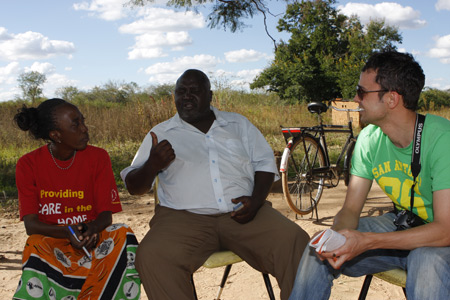
Meeting up with a CARE International representative in May 2009. At that point they didn't think they would have any spare funds to help Simakakata this year.
“We’re already up to window level on the first building,” he laughs, “We’re going very quickly, and the community is doing the vast majority of the building work. We’re hoping that we’ll have this first building completed by the end of January.”
No time to waste
Although George has the money and materials at his disposal to start work on the new school building, he doesn’t have the luxury of time. Right now the 230 children enrolled at Simkakata are taught in an old farmhouse, which has no lighting, no water and, for the most part, no windows either. It’s a hugely inappropriate building, but they may not even have that for much longer.
“The lease on our current building runs out in January,” explains George, “If the children are moved out of that building they’ll have nowhere to learn from. We’re very worried and trying to organise things. We hope to work fast, but we’re asking for a grace period of three months or so, so that we can get the roof on and complete the building.”
As a result, says George, he’s decided the priority is to press on with building the second classroom block before work starts on any teachers’ housing.
“The first block can accommodate five classes teaching on a shift rota,” he explains, “But we still need two more classrooms if we are to accommodate the whole school properly.”
A new borehole
There is more good news, though. Thanks to the commitment shown by George, his staff and the community of Simakakata, the local council has agreed to fund a borehole at the new school site so that the pupils can finally have access to clean water.
“The borehole has been drilled by the council, but they haven’t fixed a pump yet,” says George, “So we’re still without water. The pipes are in the ground, but they’re not working yet. But we hope they soon will be.”
And what of our star pupil, ten-year-old orphan Saviour? She walks 14km a day without food or water to get to school, hoping that her education will be her escape from poverty.
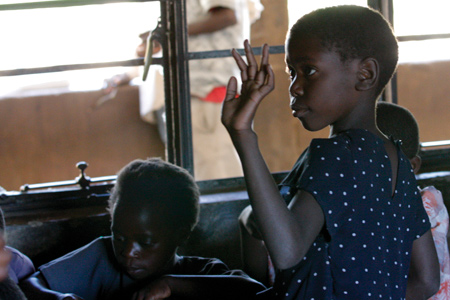
Saviour is performing well at school. Notice the lack of windows in her current classroom.
“She’s is doing very well,” George tells us, “In fact, her results are much better than last year. In her last exams she came top of the class!”
The next few months will see Simakakata Community School transformed beyond recognition from the dark, dilapidated stop gap we visited in May. With new buildings and a borehole, it will be much better equipped to give Saviour and her friends the education that they deserve. There’s still more to do before its future is assured.
Help us to raise money for the fifth classroom and the vital 5 teachers’ houses by making a donation today.
-
“Thank you very much. We appreciate your hard work.”

The text I received from Headmaster George earlier today.
A few hours ago my phone buzzed. It was a text message from George, the Headmaster at Simakakata Community School.
“Thank you very much. We appliciate your hard work.”
Given today’s general levels of excitement at LearnAsOne and in Southern Zambia I’m sure we can all forgive his spelling. Mine is often equally as bad!
Let me rewind 24 hours
Yesterday I received a cheque from Shaun Connell following his Sky dive in late September. This brought us to within £170.24 of the fundraising target for the first classroom. I posted messages on twitter and Facebook to this effect and our supporters took over. Within 24 hours the target had been reached!
I’d like to thank Claire, Adam, Simon, Nina, Gloria, Rachel, Cathryn, Maurice, Zac, Scuff and Laura for their donations which nudged the totaliser over the target. And of course to all the rest of you who have donated your time, skills and money to make this all possible.
So what happens next?
As soon as your doantions reach us from Just Giving (7-10 days) we’ll transfer the money for the first classroom to our partner Response Network in Zambia.
In the meantime they will finalise the costs of the raw materials such as cement, doors, windows and roofing sheets. And a document of understanding will be drawn up with the community at Simakakata giving them 6 months to build the classroom once the raw materials are delivered.
We’ll also work out the best way to keep you updated during the build and, after a little celebration tonight, continue fundraising for the remaining classrooms, teacher’s houses and water that the community needs.
A message from the kids
To sign off this post I’ll hand you over to the children of Simakakata.
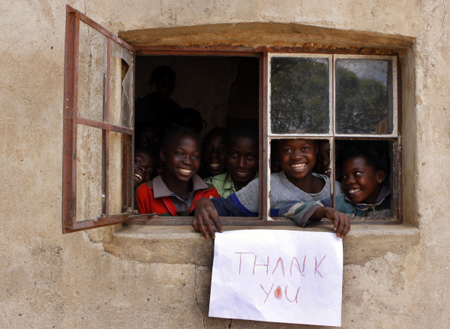
-
£15.24 away from the first classroom!
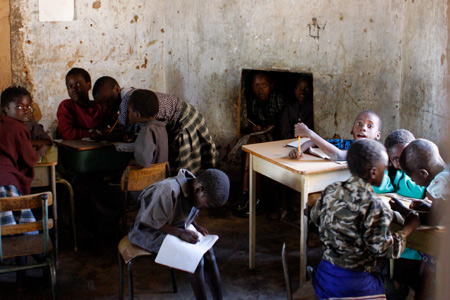
Hole in the wall: The learning conditions in the current school are far from ideal.
I have good news. Thanks to your efforts the first classroom at Simakakata is now just £170.24 £15.24 away fully funded!
Thanks to the recent efforts of 13 students and a dog at the very first WalkAsOne, Nina Preece and her eBay exploits, the sky diving Shaun Connell, the Chearsley WI cake sale team, New Era and many others the £5,200 target is now within touching distance.
Edit: Thanks to Claire, Adam, Simon, Nina, Gloria, Rachel, Cathryn, Maurice, Zac, Scuff and Laura for their donations since I shared this post on twitter and Facebook.
Below you can see the site for the new classroom. A previous donor laid the foundations and the community have made all the bricks you see by hand.
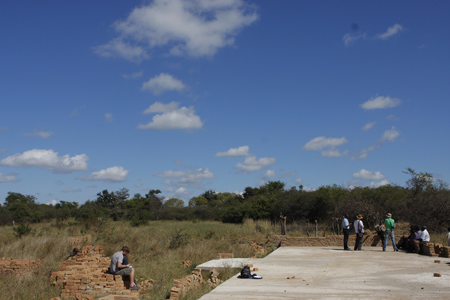
This is where the first classroom will be built.
The money raised will pay for all the other raw materials needed to build a classroom. Timber, roofing sheets, doors, glass for windows, more cement. All things the community cannot afford themselves.
The community at Simakakata have agreed to contribute by donating both skilled and unskilled labour for free. They are ready to get started as soon as the final £170.24 has been raised the funds have been transferred to our partner in Zambia and the raw materials have been purchased. We’ll provide updates throughout the build on this blog so you can see your money action.
If you would like to make a donation you can do so via this link. Thank you.
-
Simakakata Community School in 10 photos
Over the past week I’ve uploaded 10 of our favourite photos from Simakakata onto twitter. They tell the current story at the school and explain why permanent classrooms are so important to the community.
Here they are in one batch, plus a bonus photo for you all!
Photographs by our brilliant volunteer Brenda Veldtman.
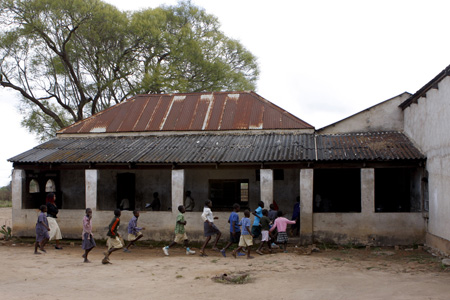
The Simakakata community borrowed an old farmhouse to get the school up and running. Now the owner wants it back.
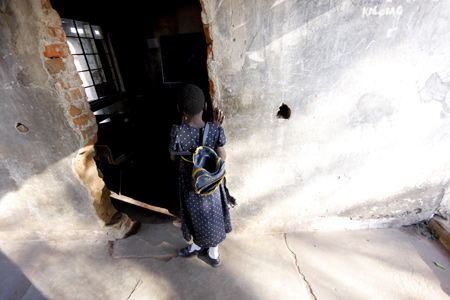
At the current school doors are seen as something of a luxury.
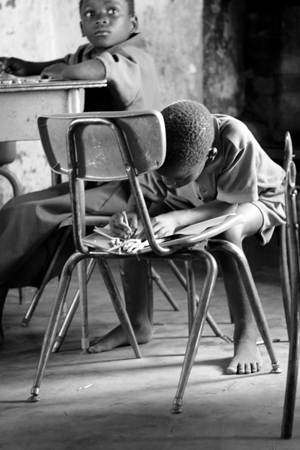
Desks are lacking.
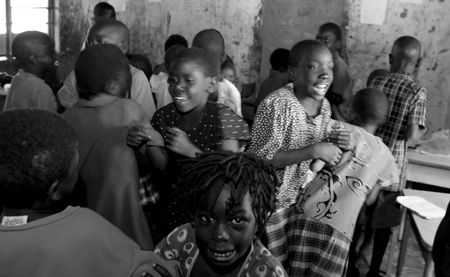
But the kids are incredibly happy to have the opportunity to attend school.
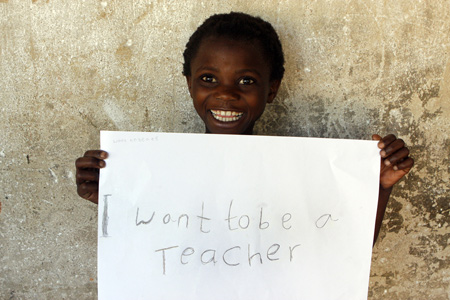
They have ambition.
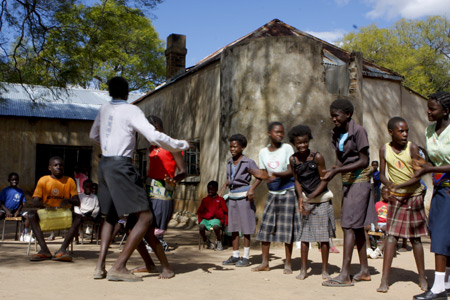
Love to have fun.
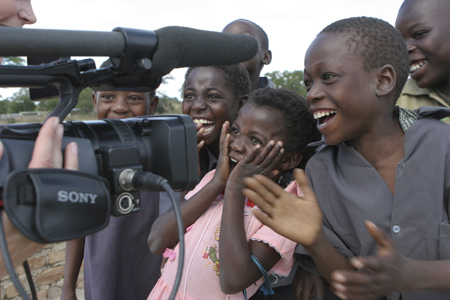
And are naturals in front of the camera!
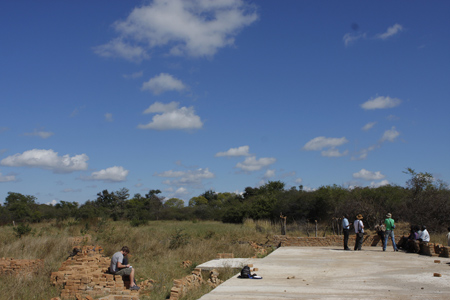
The community have built 20,000 bricks by hand. There are willing to contribute skilled and unskilled labour for free. And another donor even laid some foundations for the first classroom. Then the money ran out.
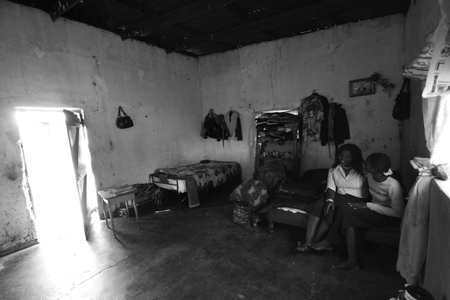
The government will provide training teachers for free if teacher's houses can be funded. The school currently has one room which two volunteer teachers call home.
And one bonus shot…
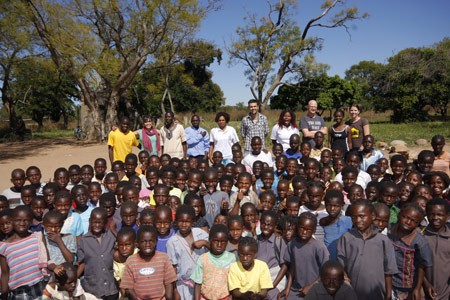
A new school would give over 200 children the chance of a better future.
We now need less than £1,000 to get the first classroom off the ground. If you would like to make a donation please click here. Thank you!
-
The sporting stars of Simakakata
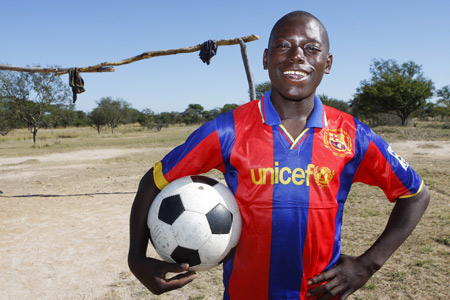
Brighton is one of the best footballers at Simakakata.
School isn’t just about learning and lessons. Thanks to volunteer teacher Edwin Kufekisa, who teaches grade 5 during the day, Simakakata also has sports lessons, as well as a football and netball team.
Seventeen-year-old Brighton, from grade 7, is one of the stars of the soccer side.
“I play as a striker, and I’m the best in the school,” he says. “Sometimes we play against the other schools in Kalomo area, but we don’t often win.”
If ever there was a place that taking part was more important than winning or losing, though, this is it. With no public transport and several hours walk to the nearest school for pupils who’ve already trekked through the bush to get to class, away games are a rare treat which are savoured regardless of the score.
His friend, Earnest, also plays in the side. He’s been coming to Simakakata for six years, since he was 11 years old. He has two sisters and a brother who are also enrolled here.
“I prefer sport to my lessons,” he says, “But I do enjoy English. It’s very important to learn English here, there’s better work and more money for people who speak English.”
The football team practice in a large field behind the school, with goalposts made from tree branches. While the team trains, other pupils sing and dance or take part in races.
Closer to the school grounds there’s a bare patch of grass with a pole and hoop for netball classes.

Volunteer teacher Loveness teaches the girls how to play netball.
Mulemwa lives nearer to school than most, but has to help her grandmother after hours, which leaves little time to practice. She’s 11-years-old and studies in grade 5, where her favourite lesson is maths.
“I’m very good at netball, and really enjoy it,” she says, “I have five sisters, and I’m better than all of them.”
School isn’t just about classes - it’s a place for the children to mix and play and develop social skills as well as the academic basics that will help them in later life. We still need to raise £1,248 to fund the first classroom at Simakakata to help guarantee the future of the school. Please donate now or help to organise your very own WalkAsOne.
-
Blogging from the bush - LearnAsOne featured in .net magazine
Great news. Volunteer Adam has written a two page feature on the Zambia trip which features in the current issue of .net magazine (available at all good newsagents).
It focuses on the shocking fact that the internet is more accessible than clean water in many parts of Zambia and how this enabled us to provide live updates from the school at Simakakata.
The article isn’t currently available online but we’ll post a link to a pdf as soon as we have one.
-
Simakakata Community School: The story so far…

Lessons take place inside a borrowed farmhouse. But for how much longer?
The community of Simakakata are inspiring. They’ve borrowed a crumbling farmhouse and turned it into a school for 230 children. They’ve persuaded the government to provide three paid teachers and have attracted four other trained volunteers.
But they face a problem. A big one. The owner of the building wants it back and there is no other buildings the school can use. They urgently need classrooms, teacher’s houses and water so the children can continue their education.
They have built 60,000 bricks and are happy to volunteer both skilled and unskilled labour to construct the school. But they can’t afford the building materials such as cement, glass, timber and roofing tiles.
Update: 4 January 2010
Thanks to your fundraising efforts in 2009 and a donation from Care International four classrooms are now fully funded and the community are busy building them. And after seeing this rapid progress the local council have agreed to drill a borehole at the school.
But time is running out as their lease on the farmhouse has now expired. The community urgently need an fifth and final classroom, and then five teachers’ houses to complete the school. (In Zambia if you provide a teachers’ house the government provides a trained teacher for free).
Here is a round up of the stories from the Simakakata, and a full breakdown of the project costs. Please forward this post on to as many people as you think will be interested, and re-tweet it on Twitter. And if you wish to make a donation please feel free. Thank you.
The stories
Not one, but four classrooms are now fully funded
Your end of year update from Simakakata. Headmaster George explains how your money is being put to work and shares wonderful news about a donation from Care International.Simakakata Community School in 10 photos
The current school at Simakakata and why they badly need new classrooms and teacher’s houses.“I’ve started something at Simakakata” - Headmaster George
George Matantilo shares his amazing story. He’s a complete inspiration and will do everything in his power to ensure the school is built.The local disabled community needs the school at Simakakata
Shabby Aongola explains how the school provides a lifeline to the disabled community.If you can’t read, life is hard
Why the community of Simakakata want to build a school.Why classrooms are important
Headman Richard Sikalunda explains why a school is more important to the community than a clinic.Inside the school at Simkakakta
Our first impressions of the derelict farmhouse which currently functions as the community school.You can’t teach a thirsty child
Right now, the school doesn’t have a borehole. This is what happens after they teach a sports class.The community contribution so far
The people of Simakakata are determined to build this school. They’ve hand crafted 60,000 bricks, and given up hours of free time.What the community still needs
Although they’ve put in a huge effort, the people of Simakakata still need your help. Here, they explain why.The sporting stars of Simakakata
School isn’t just about lessons. Learn what the children get up to on the sports field.The costs
How much will it cost?
The total amount we need to raise, broken down for full transparency.Meet the community
I want to be…
Meet the children of Simakakata Community School, and see their ambitions.Saviour’s story: A day in the life
Join 10-year-old orphan Saviour on her 14km round trip to school.Saviour’s story: The photo diary - part 1 part 2 part 3
Saviour’s day, retold in pictures.Saviour: Your questions answered
Saviour responds to the questions raised by our followers on Twitter.The teacher: Sonia’s story
Meet the inspirational Sonia Haloba Shanegubo, a teacher at Simakakata. She’s living proof of the power of education to break the cycle of poverty.If you would like to make a donation please do so. You’ll get to see your money in action every step of the way. Thank you.
-
Saviour’s story: A day in the life of a 8-year-old orphan. (3/3)
On Thursday we followed 10-year-old orphan Saviour through a typical day. The final third is a mirror image of the morning. A 7km walk home, where she is visibly tiring, followed by a small meal of nshima and more chores. By the time she is finished it’s 6pm and the light is rapidly fading. There is no time for homework before bed.
Photography by Brenda Veldtman.

Just after 3.15pm the children start the 7km walk home.

Despite the distance that lies ahead they are still in high spirits. They love having the chance to go to school.

As a 10-year-old Saviour should be in grade 4, but it's only recently that she has become strong enough to do the 14km round trip every day.

That's 70km of walking per week. Or 2,800km in a school year.

2 hours after they set off the children are back at Chibwe Farm and it's time for dinner.

The children are glad to have a second meal of the day. In a few months time the food from the harvest will be very low.

Yet more chores.

The family enjoy some quality time together around the remains of the fire.

As the last of the light starts to disappear an exhausted Saviour heads to bed.
At a quick glance the school at Simakakata looks quite good. It’s a borrowed farmhouse. A little dark perhaps, but there are four walls and a roof that doesn’t leak too much. But there is a big problem. The community doesn’t own the building and the organisation that does wants it back.
Simakakata desperately needs a new school.
A total of £5,200 is needed to fund the first classroom for Saviour and her friends. Once the community has started construction, we’ll post regular updates so you can see your money in action. Click here if you want to make a donation.
-
Saviour’s story: A day in the life of a 8-year-old orphan. (2/3)
On Thursday we followed 10-year-old orphan Saviour through a typical day. Her walk to school takes 2 hours. And when she gets there her classes are Maths, Creative and Technical Skills (CTS), English, Tonga and Social Development Studies. This is part two of her photo story.
Photography by Brenda Veldtman.
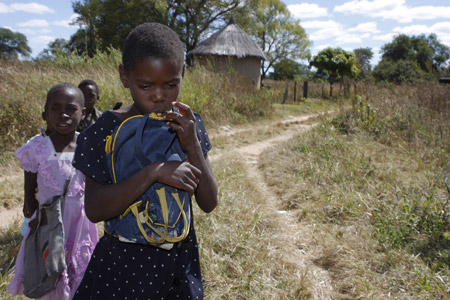
It's boiling hot and walk to school takes the children just over 2 hours. In that time they drank no water.
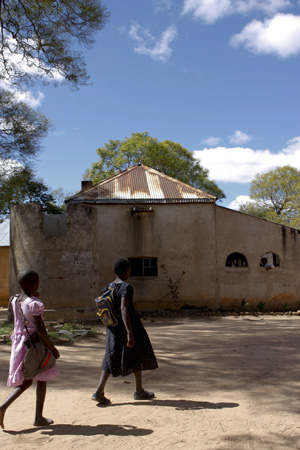
Saviour and her friends finally arrive at school. The temperature is 27 degrees in the shade.
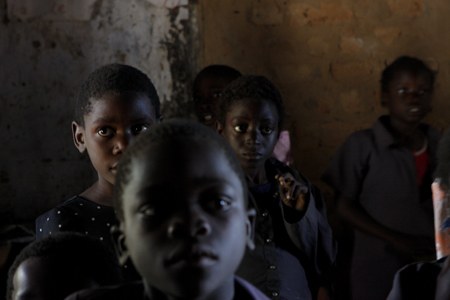
Saviour joins her grade 1 classmates and files into class for the first lesson of the day.
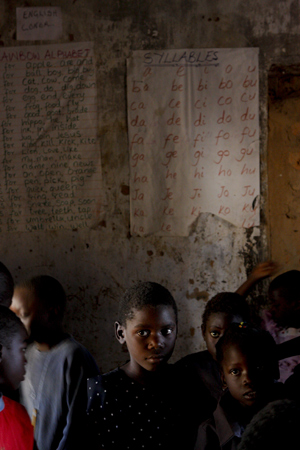
There are no teaching aids for the walls. Everything has to be painstakingly written out by hand.
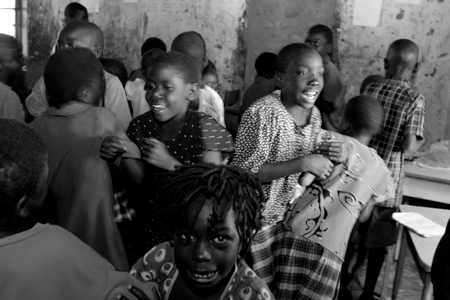
The children head for their desks.

The first lesson of the day is Maths.
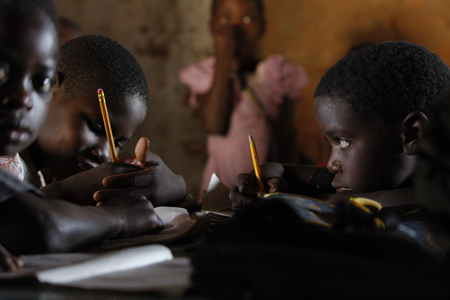
Time for the dreaded test. No cheating please!
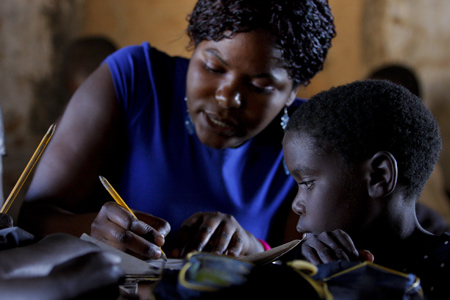
Beatrice gives Saviour a little one-to-one tuition.
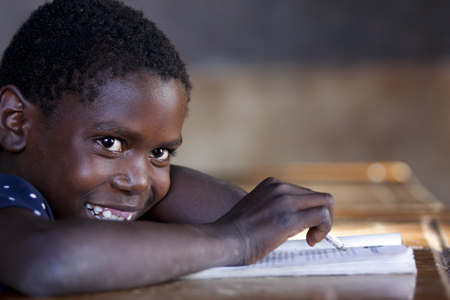
Saviour loves having the opportunity to go to school.
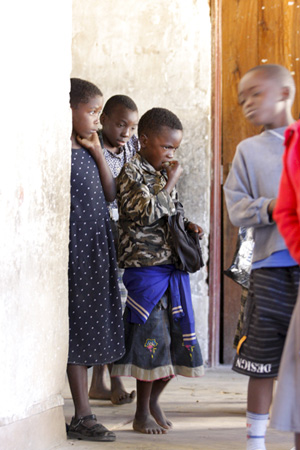
3 hours later Saviour's lessons are over for the day.
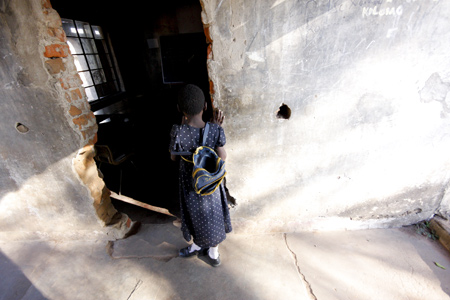
Saviour waits to get a letter off Headmaster George. Doors are seen as luxury at Simakakata.

The classrooms at Simakakata look quite good. But there is a major problem. The school is a borrowed farmhouse and the owner wants it back.
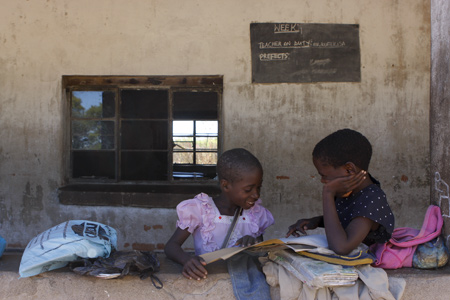
Saviour and Valencia find half an hour to do their homework before they set off home. They still have chores to do and it will be too dark to do any later.
